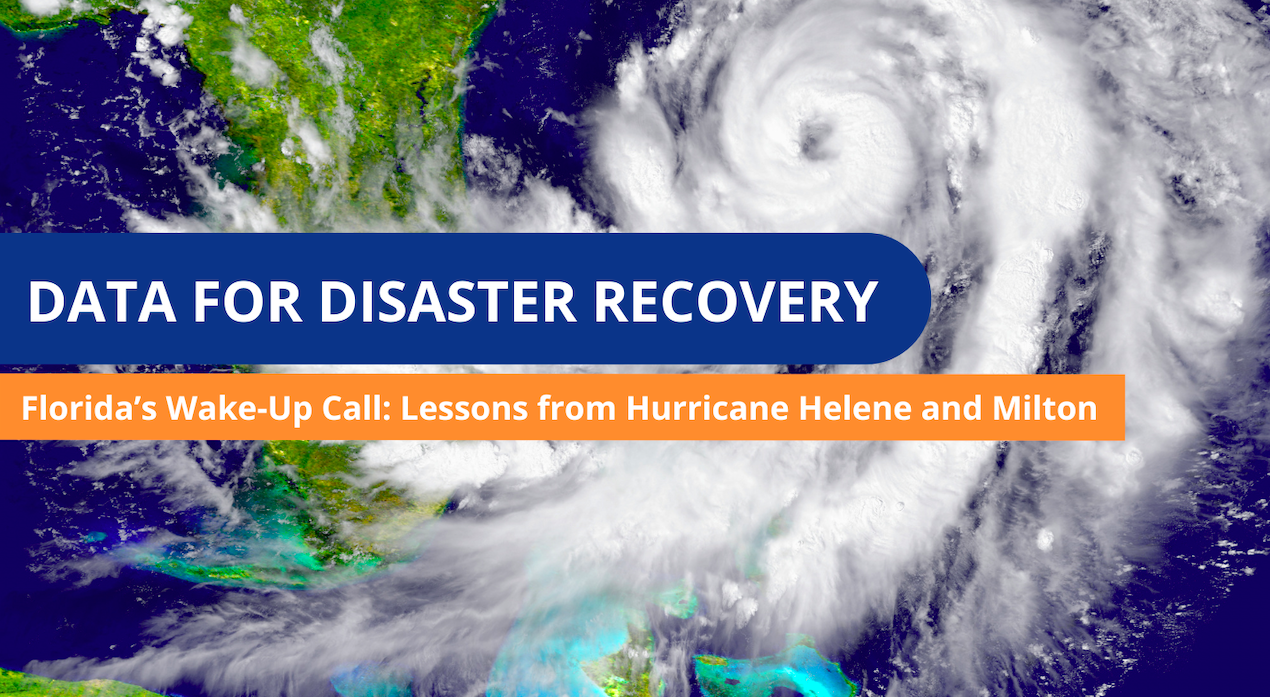Florida finds itself in the eye of the storm—again. As residents still reeling from Hurricane Helene struggle to rebuild their lives, Hurricane Milton, a once-catastrophic Category 5 storm, has brought new devastation to the state. For those who thought Helene was the worst of it, Milton has tragically proven otherwise.
With winds peaking at 180 mph, Hurricane Milton’s ferocity was ranked fifth-lowest pressure on record for any Atlantic hurricane, putting millions of people at risk, with flash floods and tornadoes wreaking havoc. Making landfall near Siesta Key, Milton’s sheer power was undeniable, causing widespread flooding, downing power lines, and displacing entire communities in shelters. With over 3.2 million residents plunged into darkness, mandatory evacuations, and at least 25 confirmed deaths, Florida woke up to a tragic aftermath. CNN even qualified Milton as Earth’s strongest storm in 2024. Are the United States prepared to face the rising toll of hurricanes as events increase in both severity and frequency?

Coastal areas face significant vulnerability to natural disasters, many with insufficient safeguards in place to fully protect against them. Today, nearly 40% of the U.S. population lives in coastal areas, many of whom are increasingly exposed to disasters, including hurricanes and high tide flooding.
Despite advancements in technology and preparedness, the unique geographical and environmental conditions of coastal regions expose them to a variety of hazards, including earthquakes, tsunamis, hurricanes, and rising sea levels. But how can coastal communities better prepare?

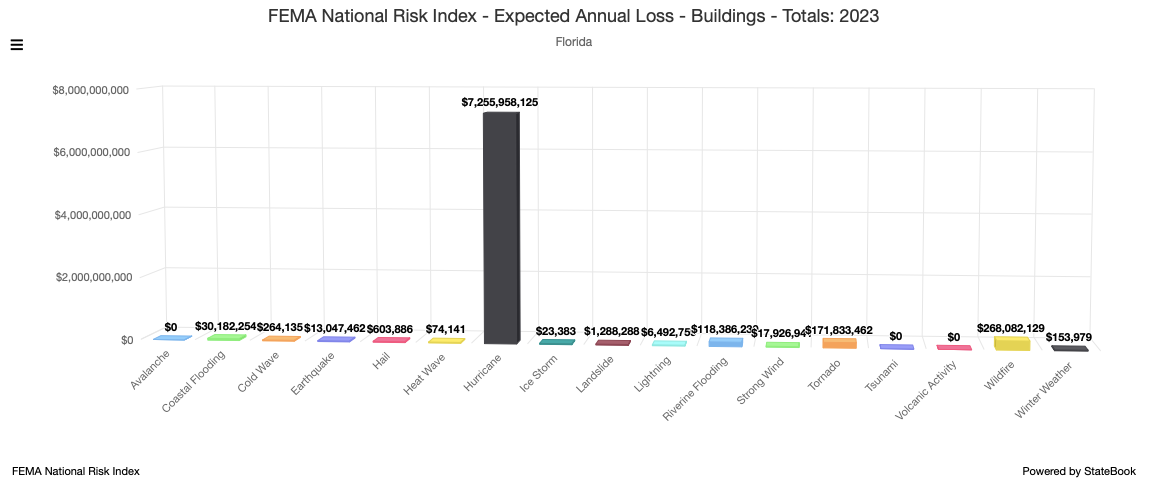
The Federal Emergency Management Agency (FEMA) data analyzed by StateBook measured an Expected Annual Loss to Building Value of more than $7 billion in Florida due to hurricanes alone. Structural failures caused by hurricanes can result in significant costs for businesses, including damage to equipment and inventory, employee displacement, and missed business opportunities. Although insurance may cover part of these losses, the process of damage assessment, filing claims, and receiving payouts can extend downtime. Additionally, businesses may not always recover the full value of their equipment and inventory, further impacting business continuity. The loss of infrastructure hampers immediate recovery and has long-lasting effects on a community’s overall resilience.
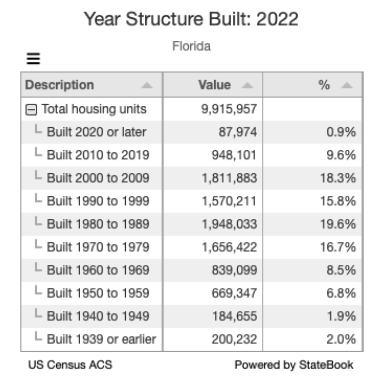
According to US Census American Community Survey (ACS) data analyzed by StateBook, around 35% of Florida’s houses were built before 1979. Natural disasters constantly threaten the state, and while building codes have evolved to better withstand some natural disaster impactss, not all structures, particularly older ones, are adequately prepared to handle large-scale quakes, fires, floods, and other hazards.
In the wake of Hurricane Helene and Milton, locals face immense challenges in rebuilding. Helene’s estimated total damage could reach $250 billion, but only a fraction of those losses—around $5 billion—are reportedly insured. According to the Insurance Information Institute, 15% to 20% of Floridians choose to forgo insurance entirely, risking their financial stability in a state where premiums have soared to four times the national average. Despite these costs, premiums don’t ensure full coverage for rebuilding. In fact, many insurance companies have withdrawn from Florida this year. As a result, many families and businesses are left struggling to recover from hurricanes.
In this challenging environment, non-traditional insurance solutions such as parametric insurance—coverage based on predetermined criteria tied to measurable disaster impacts rather than actual damages—can address significant gaps. However, parametric premiums reflect the increased risk and low-income households in high-risk areas may struggle to afford either traditional or parametric premiums.
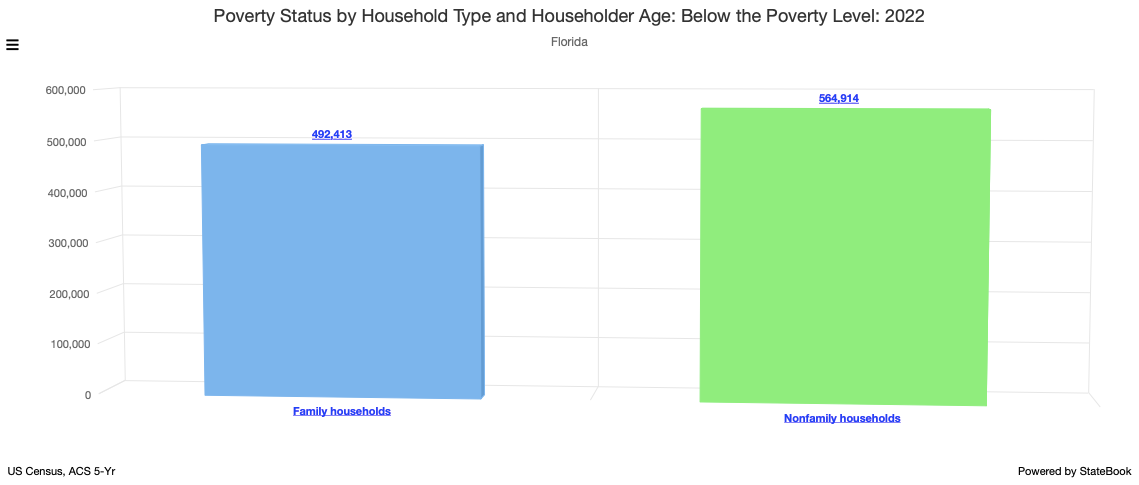

Studies suggest that homes with a disabled household member are 50% more likely to experience property damage after hurricanes. Additionally, the people with disabilities may also have lower income levels, significantly increasing the challenges they face in post-disaster recovery. Individuals with physical disabilities accounted for 13.5% of Florida’s overall population in 2022 (ACS data analyzed by StateBook). States located in disaster-prone areas must plan for access to mobility assistance, accessible evacuation shelters, and solid power sources in residential areas to protect the most vulnerable and prevent further losses.
Community Resilience in Pinellas County, Manatee County, and Sarasota
Pinellas County, Manatee County, and Sarasota were among the most impacted by Hurricane Milton. According to the FPL Power Tracker, more than 160,000 were without power in Manatee County and more than 210,000 in Sarasota County, where many roads flooded, and traffic went out. Let’s take a closer look at these communities’ resilience.
Community resilience is defined by Urban FootPrint as the ability of a community to recover from a disaster or persist sustainably in the face of a new or ongoing hardship. A 2023 BMC Public Health Research study found that promoting community resilience in the face of natural hazards should be approached with the “One Community at a Time” concept. This concept recognizes that every community is different, and for disaster and public health response efforts to work well, they must be customized to fit those unique conditions. StateBook data provides hyper-local information for every community to assess their social, economic, and environmental risks and inform their unique, robust resilience plans.

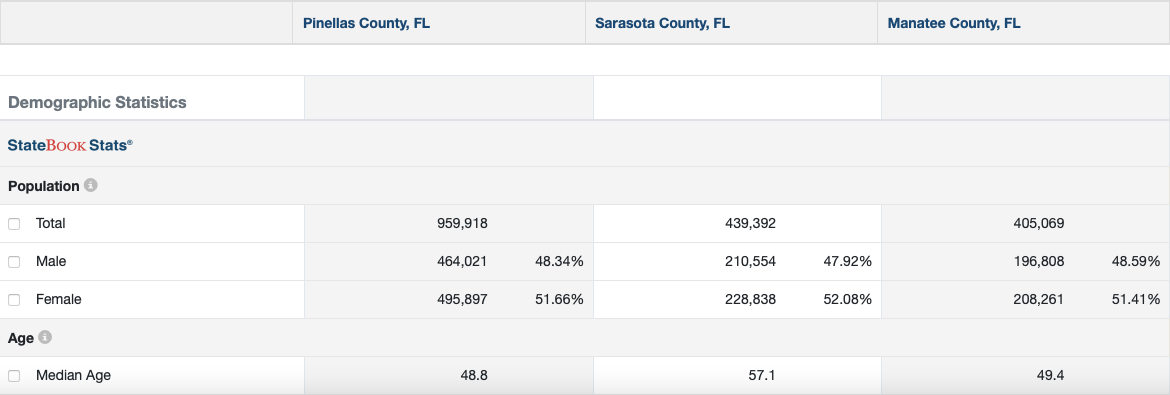
Pinellas County

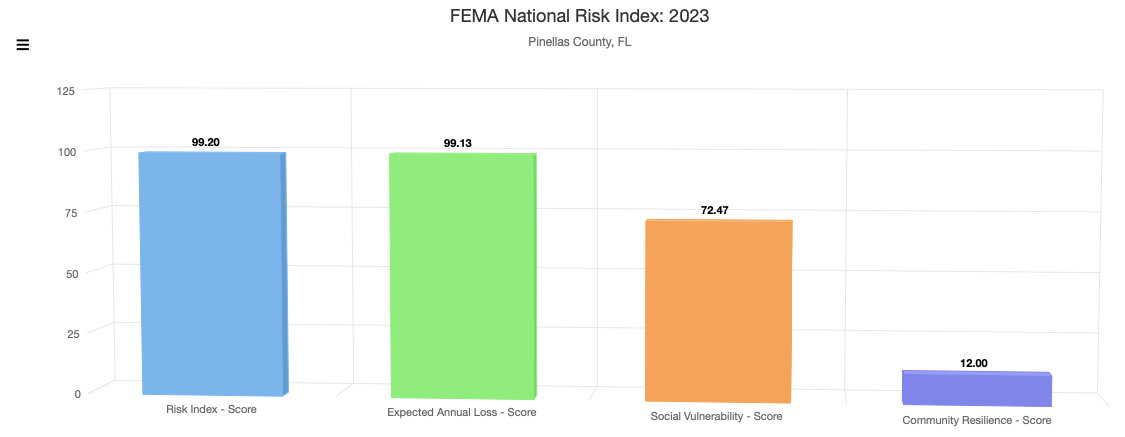
In Pinellas County, the expected annual loss due to hurricanes could rise up to $262 million (2023 FEMA data analyzed by StateBook) in buildings, with an almost total risk index score of 99%. In contrast, the community’s resilience index calculated by FEMA stands at only 12%, highlighting significant vulnerabilities in the community.
Sarasota
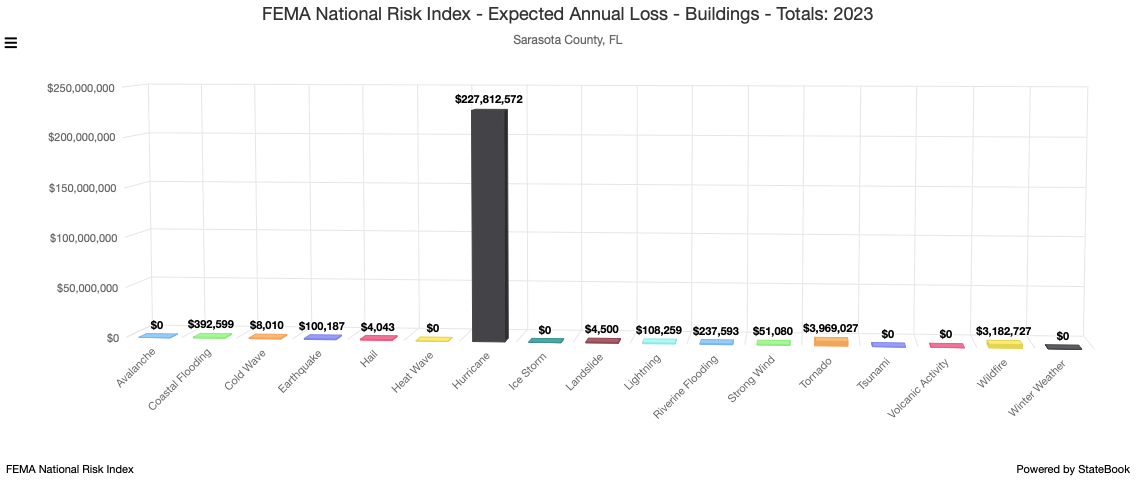
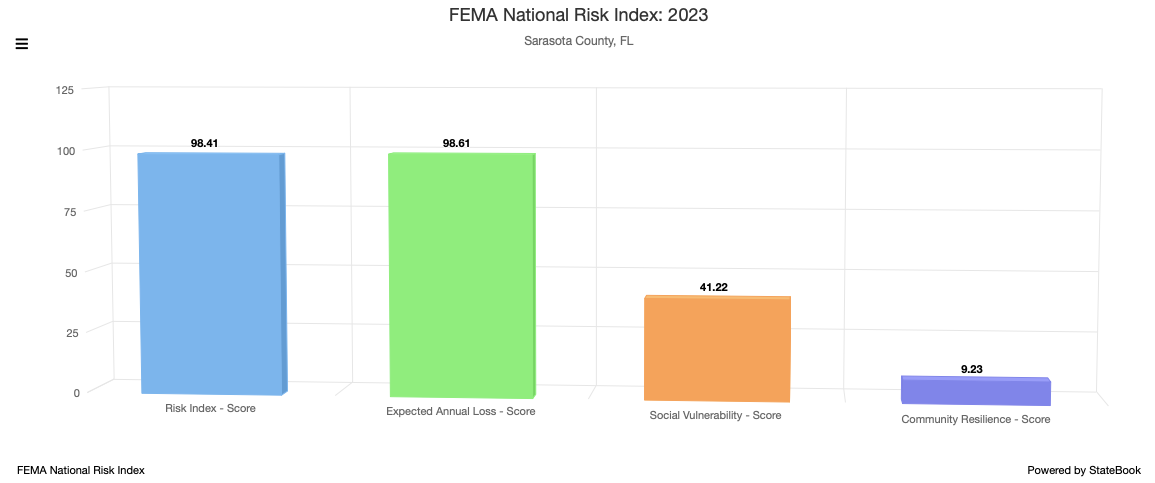
In Sarasota, the situation is even more dire. With an expected annual loss of $227 million in buildings due to hurricanes for 2023 and an index risk totaling 98% and a community resilience score as low as 9%, FEMA data analyzed by StateBook exposes a big gap in disaster preparedness in the county and shows that the community is significantly unprepared for such events, despite their frequency and potential damage.
Manatee
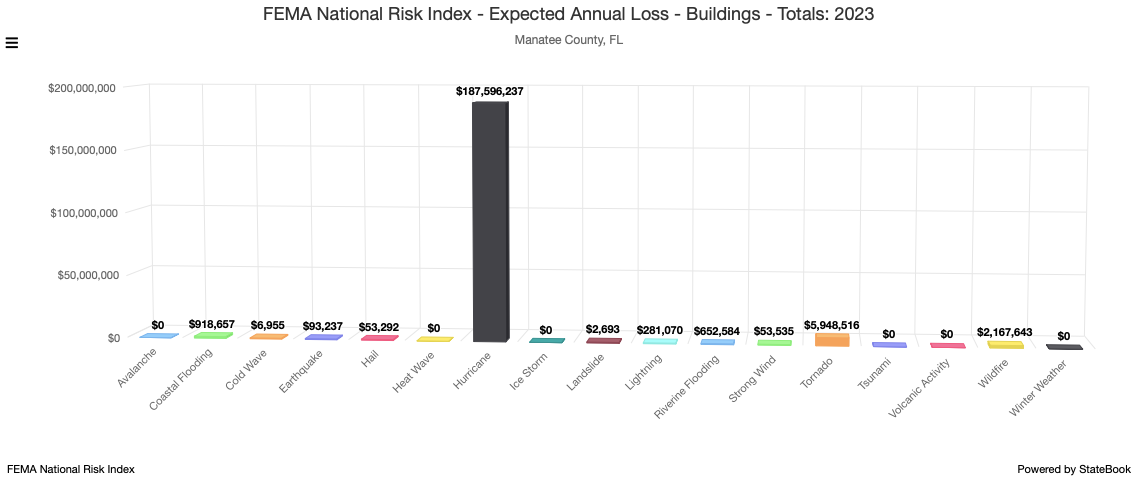
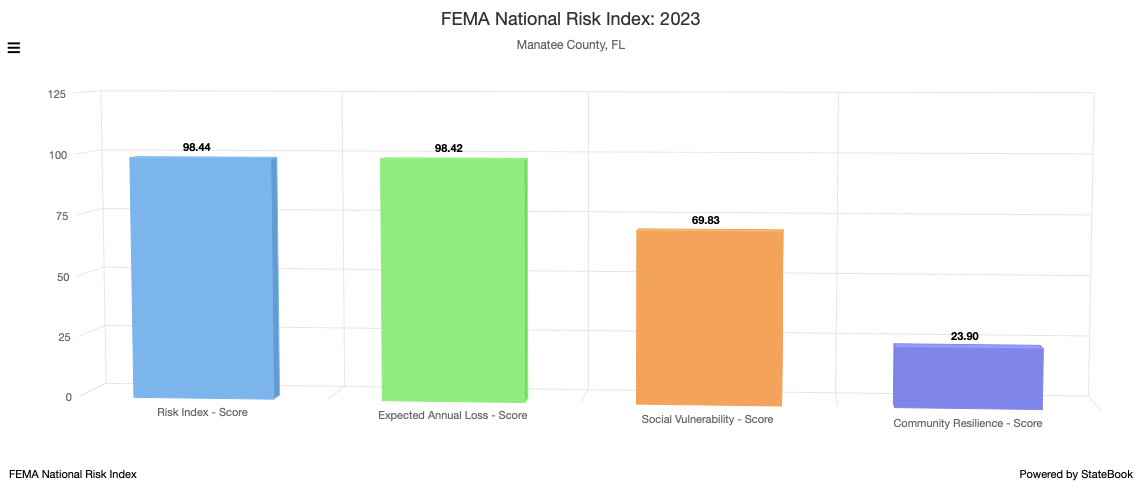
The numbers for Manatee are slightly more optimistic, as the community seems more prepared to respond to natural hazards. Although the expected annual loss was evaluated to potentially reach $167 million and the risk index is almost total, the community resilience score is almost double the counties above, amounting to about 24% (FEMA data analyzed by StateBook).
Hurricane Helene and Milton’s predicted financial impacts ($250 billion for Helene and $100 billion insured losses for Milton) far exceed the total estimated expected annual losses, indicating that the predicted financial losses for Florida were underestimated. Consequently, the situation is deteriorating more rapidly than the available FEMA data suggests.
Conclusion
Florida’s deadliest Okeechobee Hurricane claimed the lives of over 1,800 people and washed away entire towns in 1928. A century later, the technology-led public response and well-coordinated evacuation efforts during recent storms Helene and Milton proved critical in saving human lives. Although these storms caused significant damage to buildings and infrastructure, the focus now shifts to recovery and ensuring that infrastructure is rebuilt to be more resilient to better withstand the growing frequency and intensity of future natural disasters.
Drawing from the seven guiding principles for enhancing infrastructure resilience to natural disasters outlined in OECD’s Compendium of Good Practices (2024), communities can adapt to environmental changes and reduce the impacts of disasters by integrating resilience into infrastructure planning and design. Companies like StateBook can provide critical location intelligence to assess risk and inform strategy and policy. Organizations such as the Institute for Sustainable Development (ISD) and the International Sustainable Resilience Center can equip communities and organizations with the skills and knowledge to effectively plan, implement, and maintain resilient policies and infrastructure, thereby facilitating proactive resilience strategies.
To prevent more losses, communities are recommended to plan for disaster-preparedness activities and improve their resilience scores by prioritizing decisions and investments based on local needs and vulnerabilities.
By deploying advanced data on hurricane activity and other hazards, communities can pinpoint the most at-risk social, economic, and environmental risks. This approach strengthens the ability to withstand disaster events and ensures that communities allocate resources effectively. A data-driven approach through platforms like StateBook can help identify the areas that need the most support, to prioritize locations for technical assistance, inform, and set priorities to withstand the impacts of disasters on communities and local infrastructure. On the government and state level, policymakers can use this data to evaluate the effectiveness of current policies and design new ones better suited to managing risks and building resilience in communities across the United States.

